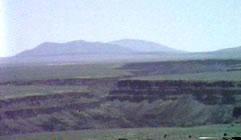

The Taos Plaza is surrounded by art galleries, restaurants and shops and is the center of many cultural activities, such as the annual Taos Fiesta and other events. Many art galleries are located on the street named after Kit Carson, which extends east from the Taos Plaza and others are scattered about town. Large, colorful hollyhocks bloom everywhere in Taos in the summertime.
Taos and the Taos Pueblo are backdropped by Taos Mountain and nearby Taos Ski Valley draws many skiers to its challenging slopes in the winter.
The spectacular Rio Grande Gorge lies to the west of town and its span bridge, the second-highest suspension bridge in the USA , offers breath-taking views of the rugged gorge, of the surrounding Taos Plateau and of the Rio Grande river that flows far below.

The
Rio Grande Gorge
Taos is a Tewa Indian word that means, “place of the red willows.” Taos was first populated by descendants of the ancestral Puebloans from the Four Corners area. The Taos Pueblo dates back to 1440. Padre de Zamora, a Spainard, had established the first mission there by 1598 and in by 1617 Spanish colonists were living in the area.
In 1680, after 100 years of Spanish rule, the Pueblo nation rebelled in what is known as the Great Pueblo Revolt .
Around 1696, Don Diego de Vargas reconquered the Indians and Spanish settlers began to populate areas near the pueblo and around what is now the Taos Plaza.
Taos later became a trading center for mountain men and pueblo Indians, and traders such as the famous, Kit Carson, who came to Taos in 1826 , came from as far away as Missouri and Mexico to trade with the hunters, trappers and Indians in Taos.
In 1847, Hispanics along with members of the Taos Pueblo fought once again, this time against American rule, and Governor Charles Bent died in the massacre that followed. Taos’ Bent street is named after the late governor.
Ernest L. Blumenschein, a famous painter, and his family moved to Taos in 1919. He is recognized as the founding father of Taos' artists' colony, which he and six other artists established as the Taos Society of Artists in 1915.
Other artists and writers were also attracted to Taos by Mabel Dodge Luhan, a wealthy heiress from Buffalo , who came to Taos in 1918. A former expatriate, who had been living a life of luxury in Florence at the turn of the century, she returned to New York City and became one of the rebels of Greenwich Village. On a trip out west, she discovered Taos. Searching for a better life, she was attracted to Taos and remained there. She later divorced her husband and married Tony Luhan, a Taos Pueblo Indian. They built a large home, near Taos on Pueblo land.
During the years between 1918 and 1962, Taos became well known in art and literary circles, as Mabel invited many famous artists, writers, and thinkers of the day to town. People, such as: D.H. Lawrence, Andrew Dasburg, Georgia O'Keeffe, and Leon Gaspard. Ansel Adams, Mary Austin, Robinson Jeffers, Laura Gilpin, Jean Toomer and other literary and cultural elite came to Taos to visit the Southwest and to explore ideas on how to reshape the social and political thinking of the day.
From those beginnings, coupled with the unique quality of light in the Taos area and the beauty of its surrounding environment, Taos continues to be a compelling attraction to artists and travelers today.
 |
|